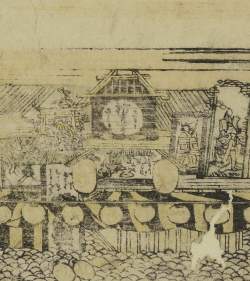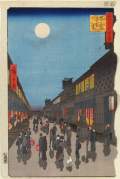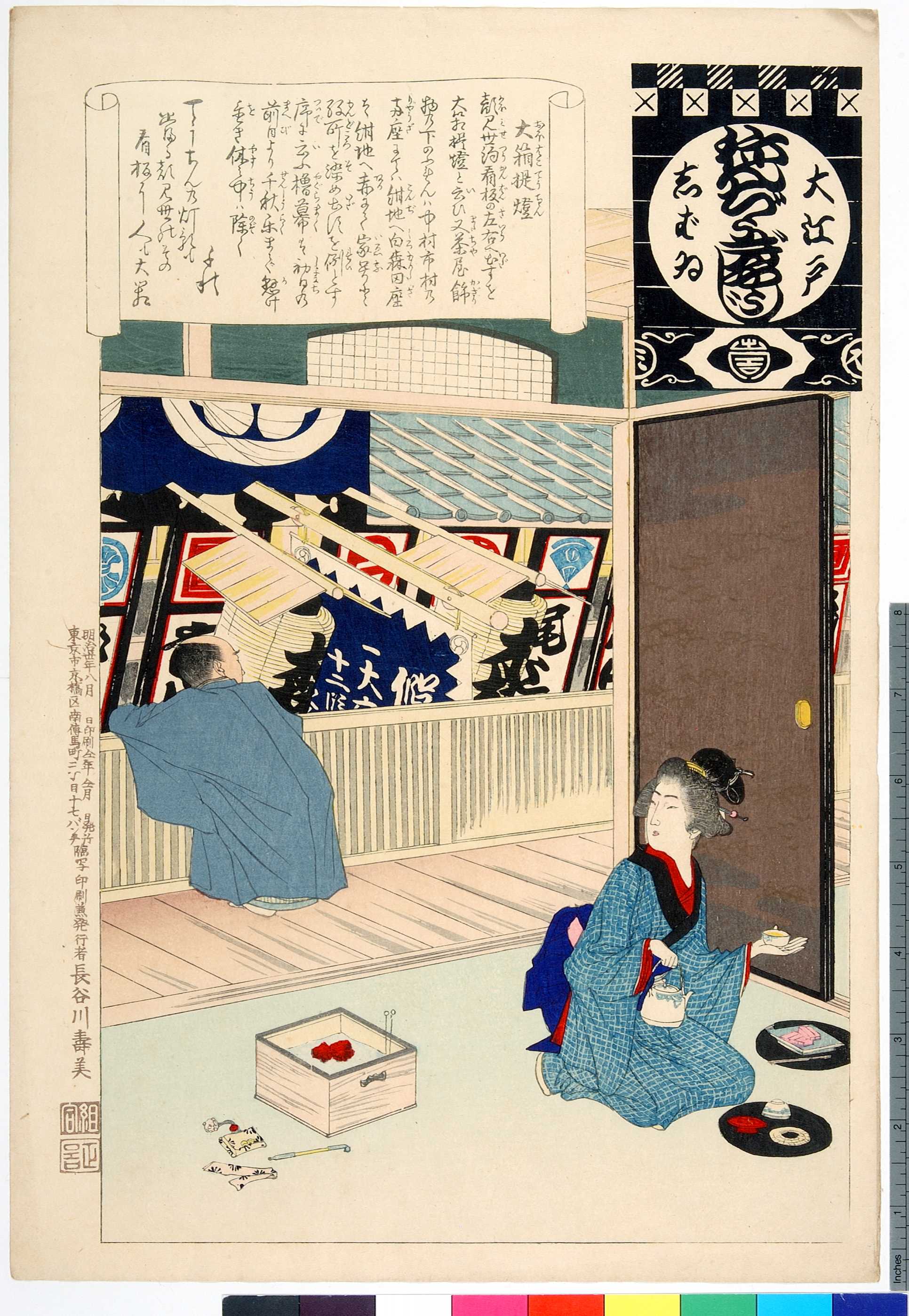B10 Theatre Tea-house
-
Ō-Edo shibai nenjū gyōji "Ōbako chōchin"
Ōban, Colour print
Artist: Adachi Ginkō; Published: Meiji 30 (1897) by Hasegawa Sumi
Ritsumeikan Art Research Center (arcUP2056) Ōbako chōchin were large lanterns suspended below the yagura (a tower erected on the roof of a theatre that represented permission to operate). The lanterns were projected out over the street in order to illuminate the announcement billboards (kanban) that were hung at the front of the theatre. These billboards were a feature of Edo (Tokyo) theatres after the theatres were forcibly relocated to Saruwakachō (Edo theatre district from the early 1840s through the 1860s). Alhough there is an illustrated book from around the 1790s in which you can see two large lanterns (see above left), there are few pictorial materials that illustrate the lanterns in their position near the billboards, probably because the yagura was put up only during a performance. For example, in Hiroshige's print "Saruwakachō Night Scene" from the series One Hundred Famous Places in Edo, we see the district when the theatres and teahouses are closed (see below right).
Ōbako chōchin were large lanterns suspended below the yagura (a tower erected on the roof of a theatre that represented permission to operate). The lanterns were projected out over the street in order to illuminate the announcement billboards (kanban) that were hung at the front of the theatre. These billboards were a feature of Edo (Tokyo) theatres after the theatres were forcibly relocated to Saruwakachō (Edo theatre district from the early 1840s through the 1860s). Alhough there is an illustrated book from around the 1790s in which you can see two large lanterns (see above left), there are few pictorial materials that illustrate the lanterns in their position near the billboards, probably because the yagura was put up only during a performance. For example, in Hiroshige's print "Saruwakachō Night Scene" from the series One Hundred Famous Places in Edo, we see the district when the theatres and teahouses are closed (see below right). Together with a patron, we look out in this print to the front of a theatre from an upstairs room in a theatre teahouse. The origin of the theatre teahouses goes back to the cha-mise of the wakashū kabuki period (kabuki acted by wakashū, or youths, from 1629-1652). Gradually, the teahouses took on a range of functions in support of the theatre-going of wealthy audience members, providing a place where one could get something to eat during breaks in the performance, change clothes, meet with favorite actors, or even call in entertainers and prostitutes. Tips were always expected, which was a big reason why a day at the theatre was so expensive.
Together with a patron, we look out in this print to the front of a theatre from an upstairs room in a theatre teahouse. The origin of the theatre teahouses goes back to the cha-mise of the wakashū kabuki period (kabuki acted by wakashū, or youths, from 1629-1652). Gradually, the teahouses took on a range of functions in support of the theatre-going of wealthy audience members, providing a place where one could get something to eat during breaks in the performance, change clothes, meet with favorite actors, or even call in entertainers and prostitutes. Tips were always expected, which was a big reason why a day at the theatre was so expensive.
[Glossary]
Edosanza,Saruwaka-machi,Yagura、Senshuraku
[Related Topics]
Theatres and Promotion -

- 投稿日:
- by 8P
- カテゴリ: B Front and Back of Kabuki Stage
- [編集]